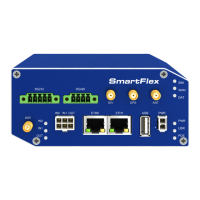SmartFlex
Network interfaces belonging to individual backup routes are also checked before use for
flags which indicate the state of the interface. (E.g. RUNNING on the Network Status page.)
This prevents, for example, the disconnection of an Ethernet cable. You can fill-in one or both
Ping IP Addresses (IPv4 and IPv6) – based on IP protocol used on particular network interface
and WAN connection settings. IPv4 and IPv6 are dual stack implemented in the router. Any
changes made to settings will be applied after pressing the Apply button.
4.7.1 Default Priorities for Backup Routes
If the Enable backup routes switching check box is unchecked, the backup routes system
will operate in the backward compatibility mode. The router selects the route based on the de-
fault priorities of the enabled settings for each of the network interfaces, enabling appropriate
services that comply with these network interfaces. The following list contains the names of
backup routes and corresponding network interfaces in order of default priorities:
• Mobile WAN (usbX)
• PPPoE (ppp0)
• WiFi STA (wlan0)
• Secondary LAN (eth1)
• Tertiary LAN (eth2)
• Primary LAN (eth0)
Example of default priorities: Backup Routes are disabled. The router selects the Sec-
ondary LAN as the default route only if you unmark the Create connection to mobile network
check box on the Mobile WAN page, unmark the Create PPPoE connection check box on the
PPPoE page and unmark the Enable WiFi on the WiFi page (or use WiFi in AP mode). To
select the Primary LAN, delete the IP address from the Secondary LAN page and disable the
DHCP Client for the Secondary LAN.
Note: Consider there is a concept of variable WAN and LAN interfaces even if the Backup
Routes are not enabled. The situation may occur, that LAN intended interface becomes WAN
interface (because of specified or default prior ities). Communication from WAN interface to
LAN interface can then be blocked depending on the NAT and Firewall Configuration.
62

